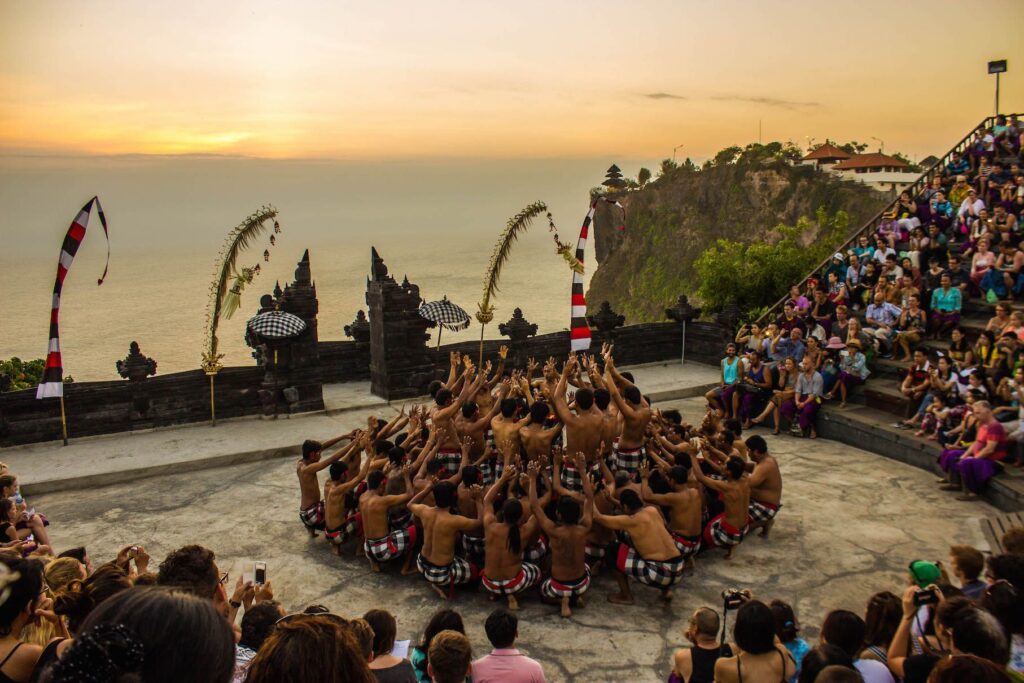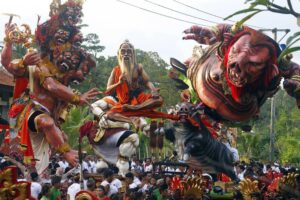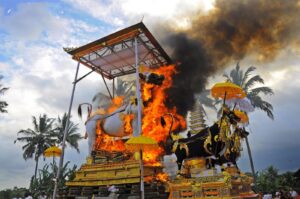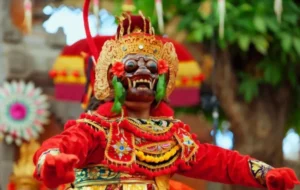The island of Bali, a tropical jewel in the heart of the Indonesian archipelago, is famous not only for its enchanting beaches and captivating nature but also for its rich cultural heritage and deeply rooted traditions that have captured the hearts of travelers from around the world. Balinese Traditions are a beautiful reflection of Indonesia’s cultural identity and richness, blending art, religion, and daily life in a unique way.
This article will guide you on a journey to explore Balinese Traditions. From unique ceremonies to various forms of art, we will delve into the cultural richness that is an integral part of Bali, while observing how these traditions continue to evolve and adapt to the modern era. Welcome to the wonderful world of Balinese culture!
10 Balinese Traditions
1.Nyepi Ceremony
The Nyepi ceremony is one of Bali’s most important and respected traditions. It celebrates the Saka New Year, which falls on the second day of the Balinese Saka calendar. Nyepi is a day of complete silence that begins with the Melasti ceremony, where people purify themselves and offer prayers on the beach as a symbol of purification.
The highlight of the Nyepi ceremony is the day of absolute silence, during which all activities, including travel, speech, and even electricity, are prohibited. During these 24 hours, the people of Bali meditate, reflect, and pray. The Nyepi ceremony is an opportunity for the residents of Bali to contemplate their lives, maintain the balance of nature, and start the new year with a fresh spirit and profound silence.
2.Galungan and Kuningan Festival
source:baligolive.com
The Galungan and Kuningan festival is one of the most significant Hindu celebrations in Bali. It is celebrated every 210 days in the Balinese Wuku calendar and marks the victory of Dharma (good) over Adharma (evil) while honoring the ancestors. The climax of the Galungan celebration occurs on Galungan day when Balinese people don traditional clothing and visit temples to pray and offer sacrifices to the gods and ancestors. Balinese people also erect “penjor,” decorated bamboo poles, in front of their homes as a symbol of victory.
Kuningan follows ten days after Galungan. On this day, Balinese people also visit temples to offer sacrifices and prayers to their ancestors. In addition, they celebrate with traditional dishes like lawar (coconut and minced meat dish) and ayam betutu (seasoned and roasted chicken). The Galungan and Kuningan festival plays a crucial role in preserving Balinese Hindu traditions and spirituality, strengthening family and community bonds.
3.Kecak Dance at Uluwatu
source:befreetour.com
The Kecak dance is one of Bali’s traditions and a popular traditional dance performance in Bali, with one of the famous places to enjoy the Kecak dance being Uluwatu. This performance combines dance with a male choir producing the distinctive “cak” sound, hence its name “Kecak.” Kecak dance performances typically narrate the epic of Ramayana, such as Rama’s battle to rescue Sita from the demon Ravana.
Kecak dance shows at Uluwatu often take place near cliffs overlooking the sea, creating a spectacular natural setting. The shows usually begin at sunset, allowing the audience to enjoy the performance while witnessing a beautiful sunset in the background. Kecak dance at Uluwatu goes beyond dramatic movements; it also creates a magical and profound atmosphere. This performance offers a unique and unforgettable cultural experience for tourists visiting Bali.
4.Melasti Ceremony
source:goodnewsfromindonesia.id
The Melasti ceremony is one of the significant Hindu ceremonies in Bali, aiming to purify and honor the sea and water deities. This ceremony usually takes place a few days before Nyepi, the day of total silence in Bali. Melasti serves as a spiritual preparation to welcome Nyepi.
During the Melasti ceremony, Balinese Hindus gather at sacred beaches or water sources. They bring various offerings, statues of deities, and worship paraphernalia to the site. During the ceremony, they physically and spiritually purify themselves by bathing in the sea or sacred water. This water is believed to purify from all sins and impurities and restore harmony with nature and the gods.
5.Ogoh-Ogoh Festival
source:beautyfulbali.blogspot.com
The Ogoh-Ogoh festival is one of Bali’s lively traditional celebrations, typically held before Nyepi, the day of total silence in Bali. Ogoh-Ogoh refers to artistic and frightening giant statues representing malevolent spirits or evil. This festival aims to ward off evil spirits and purify the environment from negative energies before entering the period of Nyepi.
On the eve of Nyepi, the people of Bali organize Ogoh-Ogoh processions throughout the island. Ogoh-Ogoh statues are paraded through village streets with gamelan orchestras, dances, and religious ceremonies. This procession is eagerly anticipated by the people of Bali, and many tourists also come to witness the spectacle. The procession culminates in a field or public square, where the Ogoh-Ogoh are displayed before being ceremoniously burned. The burning of Ogoh-Ogoh symbolizes the expulsion of evil and negative energies from the community.
6.Tumpek Wayang Festival
source:vacanzeabali.it
The Tumpek Wayang festival is a religious celebration in Bali’s Hindu tradition that honors wayang puppets and the art of wayang puppetry while celebrating Bali’s cultural heritage. Wayang kulit is a traditional art form that combines leather puppet representations with epic narratives from Hindu mythology, particularly the Mahabharata and the Ramayana.
During the Tumpek Wayang festival, Balinese Hindus hold religious ceremonies in temples to offer sacrifices to gods and ancestors associated with the art of wayang puppets. Leather puppet statues are revered, and special dances may be performed as a sign of gratitude and respect.
7.Ngaben Ceremony
source:indoculture05.blogspot.com
The Ngaben ceremony is one of the funeral rituals in Bali’s Hindu tradition, in Indonesia. This ceremony aims to purify the soul of the deceased and help it transition to the afterlife. The Ngaben ceremony is one of the most important religious rituals in Bali and is conducted with great respect for the soul of the deceased.
The Ngaben process involves several stages. First, the deceased’s body is cleaned and placed in a bamboo-made coffin. The coffin is then transported in a procession to the cremation site. There, the coffin is incinerated, and the smoke is believed to aid the soul in transitioning to the afterlife. Family members and friends present at the ceremony also participate in the procession and wear special attire as a sign of respect.
8.Bali Spirit Festival
source: theaureview.com
The Bali Spirit Festival is an annual event focusing on yoga, art, music, and culture in Bali. This event brings together thousands of participants from around the world interested in activities that promote health, fitness, balance, and an understanding of culture. The Bali Spirit Festival primarily takes place in Ubud, one of Bali’s cultural and artistic hubs.
This festival offers a variety of activities, including yoga classes, meditation, holistic therapies, artistic performances, and music concerts. Participants have the opportunity to learn and immerse themselves in health and fitness practices while connecting with like-minded communities. Additionally, the event provides a platform for local and international artists and musicians to perform on various stages and showcases.
9.The Art of Mask
source: Seruni.id
The art of the mask, also known as wayang mask art, is a traditional art form in Indonesia that involves the portrayal of masks as an essential element of artistic expression. Mask art comes in various variations and carries different meanings in Indonesian culture, with one of the most famous being the wayang mask, which is a traditional Javanese art form. Wayang masks are typically used in wayang kulit performances, which combine leather puppets with epic narratives from Hindu mythology, such as the Mahabharata and the Ramayana. In these performances, characters from these stories are represented by leather puppets illuminated by light shining through the masks.
With so many Balinese Traditions, from dazzling religious ceremonies to lively festivals and enchanting local art, Bali has much to offer to visitors seeking to explore the cultural richness of the island. If you are planning to travel to Bali, be sure to plan your visit around one of these ten cultural experiences to gain a deeper understanding of Balinese life. Bali is an extraordinary destination for exploring the beauty of its natural landscapes and the richness of its unparalleled culture.
With Salut Bali, let’s make your trip to Bali an experience that not only delights the eyes with its stunning natural landscapes but also deepens your understanding of the beauty of Bali and creates lasting memories.













